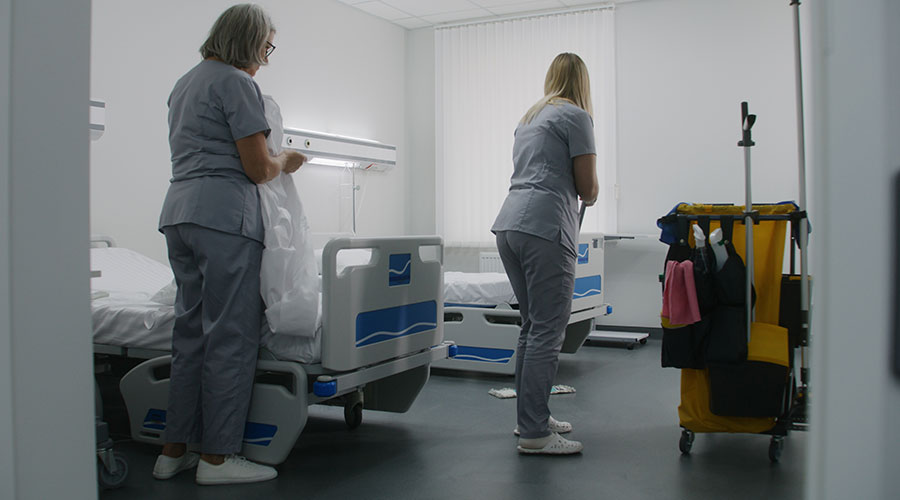What is an ambulatory strategy for a healthcare system? By strict definition, these shared words translate to:
“A plan, method, or series of maneuvers for obtaining procedures not requiring admission to a hospital for an overnight stay.”
Simply put, an ambulatory strategy is a hospital’s or health system’s desire and / or intent to expand its outpatient services further into the community. Hospital leadership often faces challenges with their ambulatory approach due to the fact that they have left the friendly and familiar confines of an acute care campus and have entered the immediate ‘home’ of their patient (i.e. consumer). True strategy plays a more critical role in their long term success once a hospital moves into this world. The traditional guidelines of healthcare change as patients now have multiple options and an increased ability to make choices based on their own needs and desires.
This article will take an in-depth look at options for enhancing ambulatory strategy beyond the typical economic analysis that incorporates traditional metrics such as market share, physician and patient supply / demand, the current competitive landscape and historical performances.
Patients, Physicians or Both?
Ambulatory care is driven by two components – patients and physicians. Ultimately, one cannot function without the other. Our industry tends to focus more on the patient side of the equation but it is not possible to have an ambulatory strategy without the appropriate physician providers in place. Having realized this essential need, health systems are in fierce competition to expand their physician networks. The opportunities outlined below will enable a health system to develop a strategy that attracts and retains physicians and strengthens its provider network. As an industry, we must begin to recognize the value and importance that physicians have on the overall ambulatory strategy.
Cut Ties with the Acute-Care Mindset
It has been published time and again, that today’s healthcare market has moved beyond the “hospital on the hill”. To achieve success, health systems must expand their geographic footprint and become accustom to life outside of the hospital. This is critical to minimize capital costs and achieve goals. Hospitals are generally at the top of the market when it comes to both first cost and life cycle costs due to the strict regulations that have to be maintained. Ambulatory space is on the opposite end of the spectrum and typically operates in Class B Occupancy allowing for much more economical options in terms of both first cost and life cycle costs. Health systems must avoid transferring their acute-care standards and mentality into the outpatient environment. Ambulatory centers are structured very differently than hospitals and must allow physicians to operate in the most efficient manner possible. An ambulatory strategy may also require the services of a new development team, one separate from the established consultants and vendors that have traditionally served the acute care campus. Old habits may be hard to break but a fresh start, in terms of team members, will allow an “ambulatory” culture to thrive.
All About the Brand
Given the growth in healthcare options, patients are becoming consumers of care rather than simply recipients. Consumers are better educated, more informed and have increasingly higher expectations. To meet, or more importantly exceed, these expectations, health systems must establish strong brands and ensure consistency of care from location to location.
Integrating the ambulatory strategy with the corporate brand will expedite adoption. Patients will always gravitate toward familiarity, especially when they have a satisfactory or positive experience. Combining brand identity with a focus on convenience and accessibility will resonate. From the paint color on the walls, to the employee culture, to the advertising campaign; everything must communicate the health system’s value proposition. The value can be tied to convenience, unique services, exceptional patient care or a physician network. Whatever you chose, it should be linked to your mission and woven into all messaging. A perfect example is The University of Texas MD Anderson Cancer Center’s successful branding strategy, established in the mid-1990s, which allowed patients to self-refer into its treatment centers. They simultaneously launched their ‘Making Cancer History’ logo and tagline which became synonymous for outpatient cancer care and its powerful desire to rid the world of cancer.
Health systems should begin to emulate retail and their approach to brand. Once established, retailers invest billions of dollars each year to maintain and protect their name and image. While billions may not be realistic or necessary, health systems are learning that they too must implement this level of commitment to support their ambulatory strategy or else jeopardize their initial investment and fall short of achieving their goals.
Set Standards and Stay Consistent
Once new standards are established, remain committed and don’t slip back into old acute care habits or processes. Changes to an established identity are confusing and will cause patients to wonder what might have gone wrong to warrant such changes. Patient confidence must remain high in order to maintain success. All too often, health systems will deviate from established practices and standards when evaluating new ambulatory locations while a successful retail / ambulatory strategy suggests just the opposite. Be sure to ask yourself if this location can maintain the identity and standards that have been established.
Operational Efficiency
An ambulatory strategy must place a heavy emphasis on how each location functions and operates from a staff and patient perspective. The tendency is to focus on how the space is physically laid out when the first consideration should be staff and patient through-put. Labor expenditures on a 10-year pro-forma will typically outweigh facility related expenditures by more than 10 to 1, heightening the need to plan operationally efficient work environments. Up-front operational planning should focus on minimizing FTE’s, maximizing clinical space and increasing patient through-put to allow for long-term positive impact on increased revenue, lower operational costs and higher patient satisfaction.
Maximize clinical space, minimize non-revenue producing space
Ambulatory business plans can be challenging to implement. Business plans, as well as approval to move forward with new locations, may face challenges such as low reimbursables for primary care, declining reimbursables for sub-specialty care, a stronger economy resulting in rising development costs, and shrinking opportunities to capture market share. Thus, health systems must maximize their revenue generating spaces such as the exam rooms, procedure rooms and imaging modalities. Reducing, re-locating and combining spaces such as waiting rooms, private physician offices, call centers, and business operations will improve the financial outlook for each location and create best-in-class ratios between revenue generating space and non-revenue generating space.
Referrals & One Stop Shopping
Developing a successful plan also requires creating the right mix between primary care and specialty care. Primary care physicians and specialists need each other for referrals. Health systems need the higher revenue generating specialists in order for their business plans to be financially feasible. Consumers and patients like having ‘one-stop shopping’ options where they have full service healthcare at one location, primarily for convenience. This also allows hospital systems to capitalize on a captured audience that may look elsewhere for services once they leave. Ambulatory destination centers provide the right marriage for both consumers and health systems to thrive under these scenarios.
Make a plan and stick with it
Often times the enemy of progress is perfection. Health systems are notorious for having a never ending evaluation and decision making process that continues to evolve and change. This creates huge challenges in the rapid fire world of retail and off-campus development. The overall development cycle for an ambulatory center should be less than 12 months from initial concept to opening. Given this short timeframe, a change in plans mid-stream or a lack of up-front decision making will have a much greater impact than what it would have on the more traditional acute care project development cycle of three to four years. Health systems need to understand what retailers have already learned - they can’t afford to second guess their strategy once a plan has been developed. Hesitating will only allow the competition to quickly take advantage of any lost momentum and capture whatever remaining market share may exist. The best locations will disappear, the patients will find alternate places for care and development opportunities will be quickly lost.
Convenience, convenience, convenience is just as important as location, location, location
Consumers want their healthcare service to be as convenient and accessible as possible. They are typically willing to go out of their way if it means a more convenient experience. The mega pharmacy retailers such as CVS and Walgreens have been able to capitalize on this approach by offering urgent “convenient” care and even primary care clinics within their stores. Consumers are drawn to this approach due to short wait times, reduced fees, and multiple locations not to mention the ability to have prescriptions available on-site immediately after their exam. An ambulatory strategy must constantly assess ways to elevate the patient experience. This can be achieved partially by physical location but can also incorporate aspects such as retail adjacencies, patient through-put, enhanced pre-registration, billing options and cohabitating services such as lab, imaging, pharmacy, food and shopping opportunities.
Flexible ownership & real estate options
Physicians want options when it comes to real estate. In the past, many owned their office space and the desire to continue investing in real estate still exists. Partnering with third party developers allows health systems to conserve capital and physician partners to participate in real estate investments through a variety of different transaction models. Physicians then have the comfort of a health system partner to minimize real estate risks. In turn, health systems will typically have additional future needs that could provide flexible options for their physical space for what is generally considered a very non-liquid asset.
Female buying power
Retailers are extremely familiar with the fact that women drive most purchase making decisions. This phenomenon holds true for healthcare. The female population is the dominant player in the ambulatory world. Referral patterns often start within OB/GYN practices and quickly move to specialists and pediatrics. Women are often the referral for other family members such as husbands or parents and create quite the domino or ripple effect. A targeted female population can often have a huge and quick impact on the success of an ambulatory plan. In addition, numerous down-stream revenue opportunities exist beyond the ambulatory center. A successful strategy will often focus on how to capture the female audience given the future buying power that this gender holds.
Learn from retailers
Retailers have learned how to function and adapt to what their consumers desire. Competition is fierce so there is no room for error when it comes to surviving and maintaining success. As a result, they have perfected all of the traits that we have focused on throughout this discussion (branding, standards, speed to market, locations, and convenience). Retailers have also learned that price point matters. In a consumer-driven world with many people going to high deductible insurance, most will shop for options more than ever before. An ambulatory strategy should incorporate a retail mentality in every aspect of its development process. If a health system is not willing to think like a retailer in regard to their ambulatory expansion they will quickly be left behind by those that do.
Facilities are important
Facilities have always played a major role within the acute-care world and that is the one similarity with ambulatory. Facilities are essentially the conduit that allows for all of the above referenced strategic components to happen. They influence the clinical operations which in turn influence the overall clinical culture which ultimately impacts the patient experience. Just because they are physically smaller does not mean that they are not important. It is critical that health systems account for ambulatory facilities within their capital budgeting and allocation processes.
Conclusion
The healthcare environment has changed drastically in just the past 10 years and shows no signs of letting up. Health systems cannot afford to sit back and maintain the status quo. Footprint expansion has become a common theme throughout board rooms and c-suites. Incorporating an ambulatory strategy and a retail mentality is a definite step in the right direction. Patients are becoming savvy consumers that are no longer willing to accept mediocre care dictated by insurance companies. Remember, brand extension, convenience, access and affordability are key drivers in exceeding patient expectations. A well thought out ambulatory strategy will put you on the right path to remain competitive and achieve your system goals.
Kyle Marden is a managing director at CBRE Healthcare.
Read article with full graphics.

 Disinfectant Dispensers in Healthcare Facilities Often Fail to Deliver Safe Concentrations: Study
Disinfectant Dispensers in Healthcare Facilities Often Fail to Deliver Safe Concentrations: Study Duke University Health System Receives $50 Million for Proton Beam Therapy Center
Duke University Health System Receives $50 Million for Proton Beam Therapy Center UT Southwestern Experiences Data Breach Through Calendar Tool
UT Southwestern Experiences Data Breach Through Calendar Tool Protecting Patient Data: Strategies and Tactics
Protecting Patient Data: Strategies and Tactics Duke Health to Acquire Lake Norman Regional Medical Center
Duke Health to Acquire Lake Norman Regional Medical Center